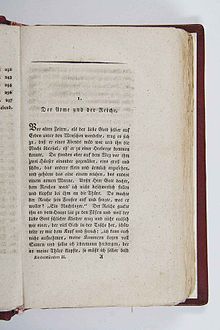The poor and the rich
The poor and the rich is a fairy tale ( ATU 750A). It is in the children's and house tales of the Brothers Grimm at position 87 (KHM 87).
content
The good Lord on the move wants to stop by a rich man in the evening, because he is probably not a burden to him, but is turned away. The poor man in the house opposite and his wife take him in kindly, eat with him and insist that he take her bed to sleep. In the morning God grants them three wishes, and the man chooses bliss, health and gets a nicer house as well. When the rich man hears this, he is annoyed. His wife lets him ride after the hiker and also ask for three wishes. God advises against it, but on the way home he ponders how he could wish enough. His restless horse bothers him so much that he wishes it dead. He walks with the saddle on his back and curses his wife, who is at home, for having to be on the saddle. At home he wants to think about his remaining wish alone, but has to release his wife from the saddle.
origin
The fairy tale has been included in the children's and household tales since the second part of the first edition, where it comes first (No. 87 in total). The notes take notes from the Schwalm area and are understandably varied. From Grimm's collection they compare KHM 13 The three little men in the forest , KHM 24 Frau Holle , KHM 135 The white and the black bride and KHM 103 The sweet porridge .
The fairy tale is likely to go back to the countless medieval receptions of the Greek myth of Philemon and Baucis .
Compare also: KHM 81 Bruder Lustig , KHM 82 De Spielhansl , KHM 142 Simeliberg , KHM 182 The gifts of the little people ; The three wishes in Ludwig Bechstein's New German Book of Fairy Tales ; Sodom and Gomorrah ; Christmas story .
Web links
Individual evidence
- ^ Röhrich, Lutz: Fairy tale - myth - legend. In: Siegmund, Wolfdietrich (ed.): Ancient myth in our fairy tales. Kassel 1984. pp. 27-30. (Publications of the European Fairy Tale Society Vol. 6; ISBN 3-87680-335-7 )
